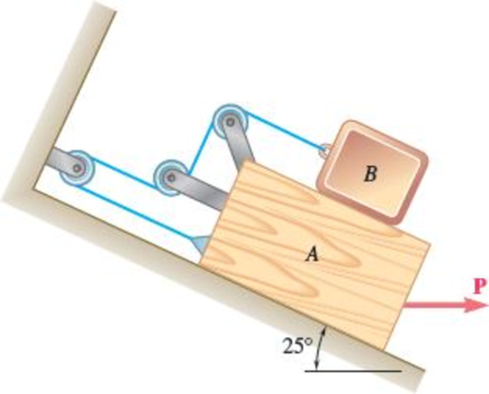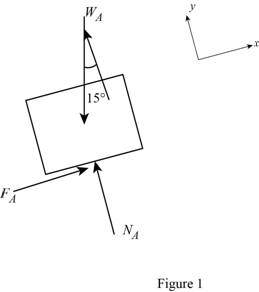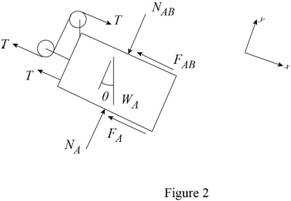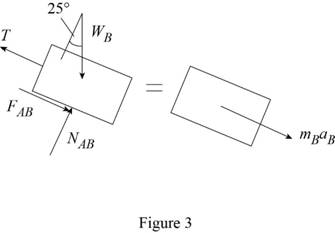
Concept explainers
Block A has a mass of 40 kg, and block B has a mass of 8 kg. The coefficients of friction between all surfaces of contact are μs = 0.20 and μk = 0.15. If P = 0, determine (a) the acceleration of block B, (b) the tension in the cord.
Fig. P12.18 and P12.19

(a)
Find the acceleration of block B.
Answer to Problem 12.18P
The acceleration of block B is
Explanation of Solution
Given information:
The mass of block A
The mass of block B
The coefficient of static friction between all surfaces of contact
The coefficient of kinetic friction between all surfaces of contact
The horizontal load (P) is zero.
Calculation:
Write the general equation of weight (W):
Here, m is the mass, g is the acceleration due to gravity.
Consider the constraint of cord.
Write total length of cable connecting block A and block B.
Here,
Differentiate Equation (1) with respect to t to write velocity of the blocks.
Here,
Differentiate Equation (2) with respect to t to write acceleration of the blocks.
Here,
Find the equation of acceleration of block B in terms of acceleration of block A.
Here,
Substitute
First of all determine whether the blocks will move for the given value of
Sketch the free body diagram of block B as shown in Figure (1).

Refer Figure (1).
Consider equilibrium along y-axis .
Here,
Substitute
Write the equation of frictional force
Substitute 0.20 for
Consider equilibrium along x-axis.
Substitute
Sketch the free body diagram of block A as shown in Figure (2).

Refer Figure (2).
Consider equilibrium along y-axis.
Here,
Substitute
Write the equation of frictional force
Substitute 0.20 for
Consider equilibrium along x-axis.
Substitute
Find the angle
Equate Equation (5) and (6).
Divide Equation (3) by
Substitute 40 kg for
The angle
Sketch the free body diagram and kinetic diagram of block B as shown in Figure (3).

Refer Figure 3.
Consider equilibrium along y-axis .
Substitute
Write the equation of frictional force
Substitute 0.15 for
Apply Newton’s law of motion along x-axis.
Substitute
Substitute 8 kg for
Sketch the free body diagram and kinetic diagram of block A as shown in Figure 4.

Refer Figure (4).
Consider equilibrium along y-axis.
Substitute
Write the equation of frictional force
Substitute 0.15 for
Apply Newton’s law of motion along x-axis.
Substitute
Substitute 40 kg for
Find the acceleration of block B
Equate equation (8) and (9).
Negative sign indicates the motion of block B in opposite to x-axis.
Thus, the acceleration of block B is
(b)
Find the tension in the cord.
Answer to Problem 12.18P
The tension in the cord is
Explanation of Solution
Calculation:
Find the tension in the cord using Equation (9).
Substitute
Thus, the tension in the cord is
Want to see more full solutions like this?
Chapter 12 Solutions
VEC MECH 180-DAT EBOOK ACCESS(STAT+DYNA)
Additional Engineering Textbook Solutions
Starting Out with Python (4th Edition)
Thermodynamics: An Engineering Approach
Starting Out with C++ from Control Structures to Objects (9th Edition)
Electric Circuits. (11th Edition)
Automotive Technology: Principles, Diagnosis, And Service (6th Edition) (halderman Automotive Series)
Database Concepts (8th Edition)
- A 4 ft 300 Ib 1000 Ib.ft 350 Ib C 2 ft 3. 45° 250 Ib B. 3ft B 25ft 200 Ib 150 Ib Replace the force system acting on the frame shown in the figure by a resultant force (magnitude and direction), and specify where its line of action intersects member (AB), measured from point (A).arrow_forwardCan you research the standard percentage of Steam Quality in:(1.) Boiler - leaving boilerBoiler -> Out(2.) Condenser - coming in condenser In -> CondenserProvide reference Also define: steam quality, its purpose and importancearrow_forwardNumbers 1 and 2 and 5 are are optional problems. However, I only need the values (with units) of 3, 4 and 6. Thank you :)arrow_forward
- Three cables are pulling on a ring located at the origin, as shown in the diagram below. FA is 200 N in magnitude with a transverse angle of 30° and an azimuth angle of 140°. FB is 240 N in magnitude with coordinate direction angles α = 135° and β = 45°. Determine the magnitude and direction of FC so that the resultant of all 3 force vectors lies on the z-axis and has a magnitude of 300 N. Specify the direction of FC using its coordinate direction angles.arrow_forwardturbomachieneryarrow_forwardauto controlsarrow_forward
- auto controlsarrow_forward1 Pleasearrow_forwardA spring cylinder system measures the pressure. Determine which spring can measure pressure between 0-1 MPa with a large excursion. The plate has a diameter of 20 mm. Also determine the displacement of each 0.1 MPa step.Spring power F=c x fF=Springpower(N)c=Spring constant (N/mm)f=Suspension (mm) How do I come up with right answer?arrow_forward
 Elements Of ElectromagneticsMechanical EngineeringISBN:9780190698614Author:Sadiku, Matthew N. O.Publisher:Oxford University Press
Elements Of ElectromagneticsMechanical EngineeringISBN:9780190698614Author:Sadiku, Matthew N. O.Publisher:Oxford University Press Mechanics of Materials (10th Edition)Mechanical EngineeringISBN:9780134319650Author:Russell C. HibbelerPublisher:PEARSON
Mechanics of Materials (10th Edition)Mechanical EngineeringISBN:9780134319650Author:Russell C. HibbelerPublisher:PEARSON Thermodynamics: An Engineering ApproachMechanical EngineeringISBN:9781259822674Author:Yunus A. Cengel Dr., Michael A. BolesPublisher:McGraw-Hill Education
Thermodynamics: An Engineering ApproachMechanical EngineeringISBN:9781259822674Author:Yunus A. Cengel Dr., Michael A. BolesPublisher:McGraw-Hill Education Control Systems EngineeringMechanical EngineeringISBN:9781118170519Author:Norman S. NisePublisher:WILEY
Control Systems EngineeringMechanical EngineeringISBN:9781118170519Author:Norman S. NisePublisher:WILEY Mechanics of Materials (MindTap Course List)Mechanical EngineeringISBN:9781337093347Author:Barry J. Goodno, James M. GerePublisher:Cengage Learning
Mechanics of Materials (MindTap Course List)Mechanical EngineeringISBN:9781337093347Author:Barry J. Goodno, James M. GerePublisher:Cengage Learning Engineering Mechanics: StaticsMechanical EngineeringISBN:9781118807330Author:James L. Meriam, L. G. Kraige, J. N. BoltonPublisher:WILEY
Engineering Mechanics: StaticsMechanical EngineeringISBN:9781118807330Author:James L. Meriam, L. G. Kraige, J. N. BoltonPublisher:WILEY





